Ekaterina Artemova
Low-Resource, High-Impact: Building Corpora for Inclusive Language Technologies
Dec 16, 2025Abstract:This tutorial (https://tum-nlp.github.io/low-resource-tutorial) is designed for NLP practitioners, researchers, and developers working with multilingual and low-resource languages who seek to create more equitable and socially impactful language technologies. Participants will walk away with a practical toolkit for building end-to-end NLP pipelines for underrepresented languages -- from data collection and web crawling to parallel sentence mining, machine translation, and downstream applications such as text classification and multimodal reasoning. The tutorial presents strategies for tackling the challenges of data scarcity and cultural variance, offering hands-on methods and modeling frameworks. We will focus on fair, reproducible, and community-informed development approaches, grounded in real-world scenarios. We will showcase a diverse set of use cases covering over 10 languages from different language families and geopolitical contexts, including both digitally resource-rich and severely underrepresented languages.
Surveying Professional Writers on AI: Limitations, Expectations, and Fears
Apr 07, 2025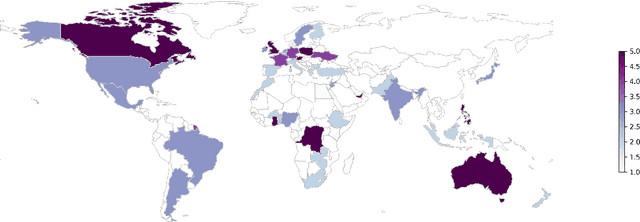
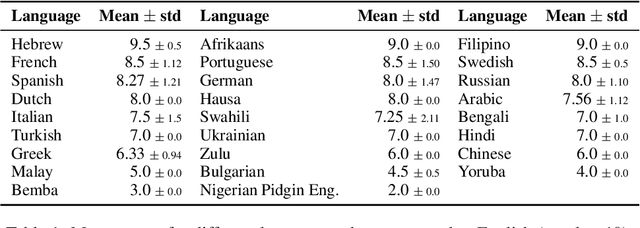

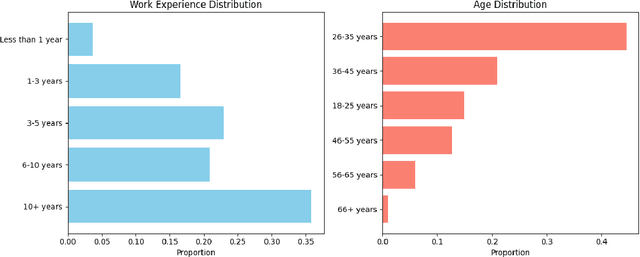
Abstract:The rapid development of AI-driven tools, particularly large language models (LLMs), is reshaping professional writing. Still, key aspects of their adoption such as languages support, ethics, and long-term impact on writers voice and creativity remain underexplored. In this work, we conducted a questionnaire (N = 301) and an interactive survey (N = 36) targeting professional writers regularly using AI. We examined LLM-assisted writing practices across 25+ languages, ethical concerns, and user expectations. The findings of the survey demonstrate important insights, reflecting upon the importance of: LLMs adoption for non-English speakers; the degree of misinformation, domain and style adaptation; usability and key features of LLMs. These insights can guide further development, benefiting both writers and a broader user base.
JEEM: Vision-Language Understanding in Four Arabic Dialects
Mar 27, 2025Abstract:We introduce JEEM, a benchmark designed to evaluate Vision-Language Models (VLMs) on visual understanding across four Arabic-speaking countries: Jordan, The Emirates, Egypt, and Morocco. JEEM includes the tasks of image captioning and visual question answering, and features culturally rich and regionally diverse content. This dataset aims to assess the ability of VLMs to generalize across dialects and accurately interpret cultural elements in visual contexts. In an evaluation of five prominent open-source Arabic VLMs and GPT-4V, we find that the Arabic VLMs consistently underperform, struggling with both visual understanding and dialect-specific generation. While GPT-4V ranks best in this comparison, the model's linguistic competence varies across dialects, and its visual understanding capabilities lag behind. This underscores the need for more inclusive models and the value of culturally-diverse evaluation paradigms.
REPA: Russian Error Types Annotation for Evaluating Text Generation and Judgment Capabilities
Mar 17, 2025Abstract:Recent advances in large language models (LLMs) have introduced the novel paradigm of using LLMs as judges, where an LLM evaluates and scores the outputs of another LLM, which often correlates highly with human preferences. However, the use of LLM-as-a-judge has been primarily studied in English. In this paper, we evaluate this framework in Russian by introducing the Russian Error tyPes Annotation dataset (REPA), a dataset of 1k user queries and 2k LLM-generated responses. Human annotators labeled each response pair expressing their preferences across ten specific error types, as well as selecting an overall preference. We rank six generative LLMs across the error types using three rating systems based on human preferences. We also evaluate responses using eight LLM judges in zero-shot and few-shot settings. We describe the results of analyzing the judges and position and length biases. Our findings reveal a notable gap between LLM judge performance in Russian and English. However, rankings based on human and LLM preferences show partial alignment, suggesting that while current LLM judges struggle with fine-grained evaluation in Russian, there is potential for improvement.
Is Human-Like Text Liked by Humans? Multilingual Human Detection and Preference Against AI
Feb 17, 2025



Abstract:Prior studies have shown that distinguishing text generated by large language models (LLMs) from human-written one is highly challenging, and often no better than random guessing. To verify the generalizability of this finding across languages and domains, we perform an extensive case study to identify the upper bound of human detection accuracy. Across 16 datasets covering 9 languages and 9 domains, 19 annotators achieved an average detection accuracy of 87.6%, thus challenging previous conclusions. We find that major gaps between human and machine text lie in concreteness, cultural nuances, and diversity. Prompting by explicitly explaining the distinctions in the prompts can partially bridge the gaps in over 50% of the cases. However, we also find that humans do not always prefer human-written text, particularly when they cannot clearly identify its source.
GenAI Content Detection Task 1: English and Multilingual Machine-Generated Text Detection: AI vs. Human
Jan 19, 2025Abstract:We present the GenAI Content Detection Task~1 -- a shared task on binary machine generated text detection, conducted as a part of the GenAI workshop at COLING 2025. The task consists of two subtasks: Monolingual (English) and Multilingual. The shared task attracted many participants: 36 teams made official submissions to the Monolingual subtask during the test phase and 26 teams -- to the Multilingual. We provide a comprehensive overview of the data, a summary of the results -- including system rankings and performance scores -- detailed descriptions of the participating systems, and an in-depth analysis of submissions. https://github.com/mbzuai-nlp/COLING-2025-Workshop-on-MGT-Detection-Task1
U-MATH: A University-Level Benchmark for Evaluating Mathematical Skills in LLMs
Dec 04, 2024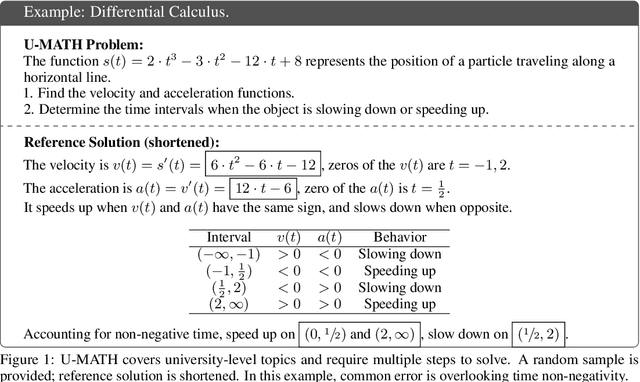
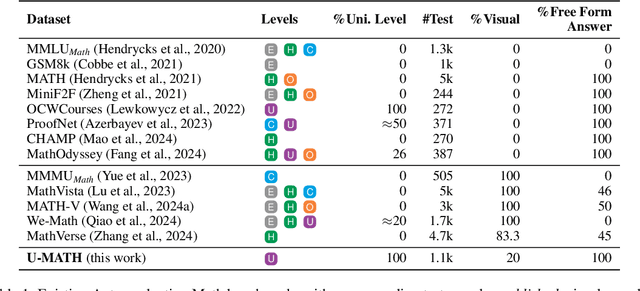
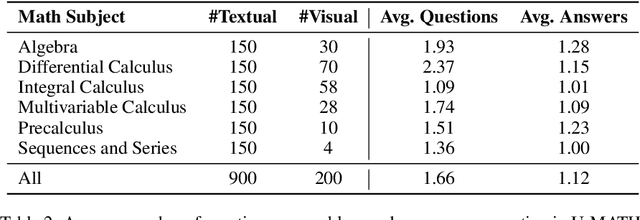

Abstract:The current evaluation of mathematical skills in LLMs is limited, as existing benchmarks are either relatively small, primarily focus on elementary and high-school problems, or lack diversity in topics. Additionally, the inclusion of visual elements in tasks remains largely under-explored. To address these gaps, we introduce U-MATH, a novel benchmark of 1,100 unpublished open-ended university-level problems sourced from teaching materials. It is balanced across six core subjects, with 20% of multimodal problems. Given the open-ended nature of U-MATH problems, we employ an LLM to judge the correctness of generated solutions. To this end, we release $\mu$-MATH, a dataset to evaluate the LLMs' capabilities in judging solutions. The evaluation of general domain, math-specific, and multimodal LLMs highlights the challenges presented by U-MATH. Our findings reveal that LLMs achieve a maximum accuracy of only 63% on text-based tasks, with even lower 45% on visual problems. The solution assessment proves challenging for LLMs, with the best LLM judge having an F1-score of 80% on $\mu$-MATH.
Hands-On Tutorial: Labeling with LLM and Human-in-the-Loop
Nov 07, 2024Abstract:Training and deploying machine learning models relies on a large amount of human-annotated data. As human labeling becomes increasingly expensive and time-consuming, recent research has developed multiple strategies to speed up annotation and reduce costs and human workload: generating synthetic training data, active learning, and hybrid labeling. This tutorial is oriented toward practical applications: we will present the basics of each strategy, highlight their benefits and limitations, and discuss in detail real-life case studies. Additionally, we will walk through best practices for managing human annotators and controlling the quality of the final dataset. The tutorial includes a hands-on workshop, where attendees will be guided in implementing a hybrid annotation setup. This tutorial is designed for NLP practitioners from both research and industry backgrounds who are involved in or interested in optimizing data labeling projects.
Beemo: Benchmark of Expert-edited Machine-generated Outputs
Nov 06, 2024Abstract:The rapid proliferation of large language models (LLMs) has increased the volume of machine-generated texts (MGTs) and blurred text authorship in various domains. However, most existing MGT benchmarks include single-author texts (human-written and machine-generated). This conventional design fails to capture more practical multi-author scenarios, where the user refines the LLM response for natural flow, coherence, and factual correctness. Our paper introduces the Benchmark of Expert-edited Machine-generated Outputs (Beemo), which includes 6.5k texts written by humans, generated by ten instruction-finetuned LLMs, and edited by experts for various use cases, ranging from creative writing to summarization. Beemo additionally comprises 13.1k machine-generated and LLM-edited texts, allowing for diverse MGT detection evaluation across various edit types. We document Beemo's creation protocol and present the results of benchmarking 33 configurations of MGT detectors in different experimental setups. We find that expert-based editing evades MGT detection, while LLM-edited texts are unlikely to be recognized as human-written. Beemo and all materials are publicly available.
LLM-DetectAIve: a Tool for Fine-Grained Machine-Generated Text Detection
Aug 08, 2024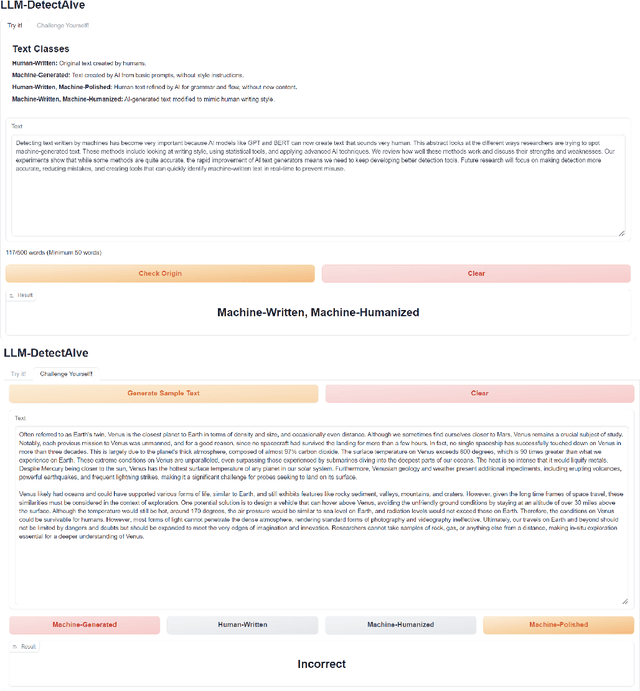
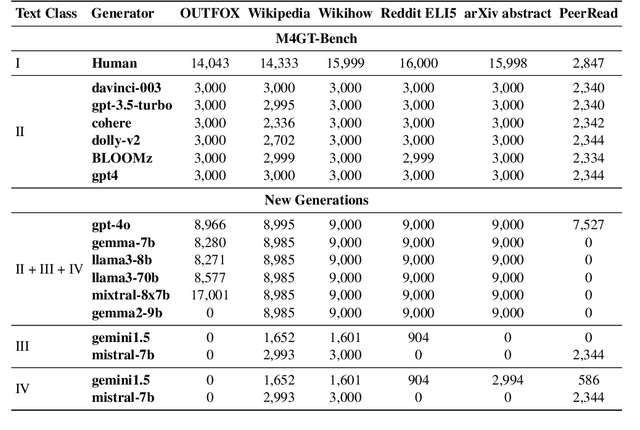

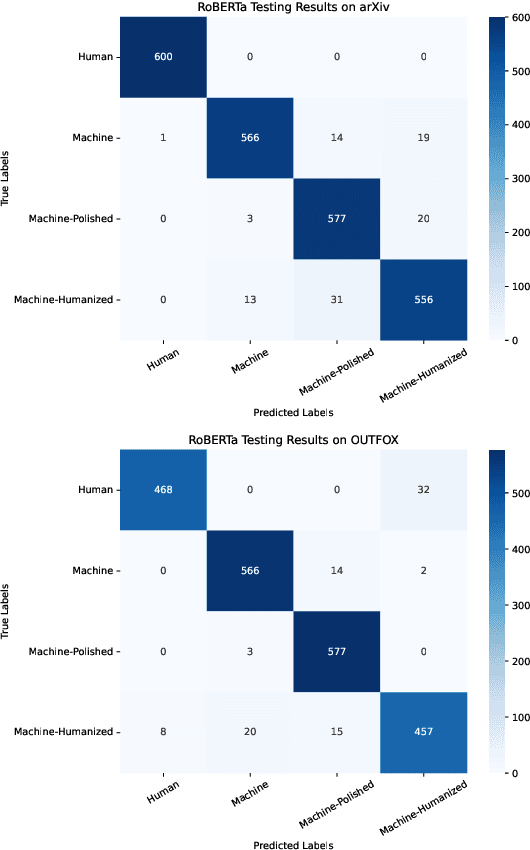
Abstract:The widespread accessibility of large language models (LLMs) to the general public has significantly amplified the dissemination of machine-generated texts (MGTs). Advancements in prompt manipulation have exacerbated the difficulty in discerning the origin of a text (human-authored vs machinegenerated). This raises concerns regarding the potential misuse of MGTs, particularly within educational and academic domains. In this paper, we present $\textbf{LLM-DetectAIve}$ -- a system designed for fine-grained MGT detection. It is able to classify texts into four categories: human-written, machine-generated, machine-written machine-humanized, and human-written machine-polished. Contrary to previous MGT detectors that perform binary classification, introducing two additional categories in LLM-DetectiAIve offers insights into the varying degrees of LLM intervention during the text creation. This might be useful in some domains like education, where any LLM intervention is usually prohibited. Experiments show that LLM-DetectAIve can effectively identify the authorship of textual content, proving its usefulness in enhancing integrity in education, academia, and other domains. LLM-DetectAIve is publicly accessible at https://huggingface.co/spaces/raj-tomar001/MGT-New. The video describing our system is available at https://youtu.be/E8eT_bE7k8c.
 Add to Chrome
Add to Chrome Add to Firefox
Add to Firefox Add to Edge
Add to Edge